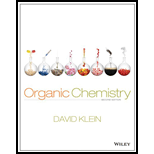
(a)
Interpretation:
The mechanism, rate, changes in rate when concentration of base is doubled, energy diagram and transition state of the given reaction of
Concept introduction:
E2 reaction is a bimolecular elimination reaction in which alkene compounds formed in a single step.
Curved arrows are used for drawing the mechanism of reaction.
Rate of E2 reaction is depends upon the concentration of substrate and concentration of base. Because in a bimolecular reaction, there should involves two chemical entities.
Equation for the rate of E2 reaction is,
Energy diagram of an E2 reaction has only one hump because only one step is involved in the E2 reaction.
Transition state is a state in between the reactant and product.
In the transition state of E2 reaction: the abstraction of β-proton by the base, removal of leaving group (halo-group) and formation of double bond are taking place.
(b)
Interpretation:
The mechanism, rate, changes in rate when concentration of base is doubled, energy diagram and transition state of the given reaction of
Concept introduction:
E2 reaction is a bimolecular elimination reaction in which alkene compounds formed in a single step. Alkenes are formed when alkyl halides are treated with bases via eliminating one β-proton and one α-halo group of the alkyl halide.
Curved arrows are used for drawing the mechanism of reaction.
Rate of E2 reaction is depends upon the concentration of substrate and concentration of base. Because in a bimolecular reaction, there should involves two chemical entities.
Equation for the rate of E2 reaction is,
Energy diagram of an E2 reaction has only one hump because only one step is involved in the E2 reaction.
Transition state is a state in between the reactant and product.
In the transition state of E2 reaction: the abstraction of β-proton by the base, removal of leaving group (halo-group) and formation of double bond are taking place.
(c)
Interpretation:
The mechanism, rate, changes in rate when concentration of base is doubled, energy diagram and transition state of the given reaction of
Concept introduction:
E2 reaction is a bimolecular elimination reaction in which alkene compounds formed in a single step. Alkenes are formed when alkyl halides are treated with bases via eliminating one β-proton and one α-halo group of the alkyl halide.
Curved arrows are used for drawing the mechanism of reaction.
Rate of E2 reaction is depends upon the concentration of substrate and concentration of base. Because in a bimolecular reaction, there should involves two chemical entities.
Equation for the rate of E2 reaction is,
Energy diagram of an E2 reaction has only one hump because only one step is involved in the E2 reaction.
Transition state is a state in between the reactant and product.
In the transition state of E2 reaction: the abstraction of β-proton by the base, removal of leaving group (halo-group) and formation of double bond are taking place.
(d)
Interpretation:
The mechanism, rate, changes in rate when concentration of base is doubled, energy diagram and transition state of the given reaction of
Concept introduction:
E2 reaction is a bimolecular elimination reaction in which alkene compounds formed in a single step. Alkenes are formed when alkyl halides are treated with bases via eliminating one β-proton and one α-halo group of the alkyl halide.
Curved arrows are used for drawing the mechanism of reaction.
Rate of E2 reaction is depends upon the concentration of substrate and concentration of base. Because in a bimolecular reaction, there should involves two chemical entities.
Equation for the rate of E2 reaction is,
Energy diagram of an E2 reaction has only one hump because only one step is involved in the E2 reaction.
Transition state is a state in between the reactant and product.
In the transition state of E2 reaction: the abstraction of β-proton by the base, removal of leaving group (halo-group) and formation of double bond are taking place.
(e)
Interpretation:
The mechanism, rate, changes in rate when concentration of base is doubled, energy diagram and transition state of the given reaction of
Concept introduction:
E2 reaction is a bimolecular elimination reaction in which alkene compounds formed in a single step. Alkenes are formed when alkyl halides are treated with bases via eliminating one β-proton and one α-halo group of the alkyl halide.
Curved arrows are used for drawing the mechanism of reaction.
Rate of E2 reaction is depends upon the concentration of substrate and concentration of base. Because in a bimolecular reaction, there should involves two chemical entities.
Equation for the rate of E2 reaction is,
Energy diagram of an E2 reaction has only one hump because only one step is involved in the E2 reaction.
Transition state is a state in between the reactant and product.
In the transition state of E2 reaction: the abstraction of β-proton by the base, removal of leaving group (halo-group) and formation of double bond are taking place.
Want to see the full answer?
Check out a sample textbook solution
Chapter 8 Solutions
Organic Chemistry
 ChemistryChemistryISBN:9781305957404Author:Steven S. Zumdahl, Susan A. Zumdahl, Donald J. DeCostePublisher:Cengage Learning
ChemistryChemistryISBN:9781305957404Author:Steven S. Zumdahl, Susan A. Zumdahl, Donald J. DeCostePublisher:Cengage Learning ChemistryChemistryISBN:9781259911156Author:Raymond Chang Dr., Jason Overby ProfessorPublisher:McGraw-Hill Education
ChemistryChemistryISBN:9781259911156Author:Raymond Chang Dr., Jason Overby ProfessorPublisher:McGraw-Hill Education Principles of Instrumental AnalysisChemistryISBN:9781305577213Author:Douglas A. Skoog, F. James Holler, Stanley R. CrouchPublisher:Cengage Learning
Principles of Instrumental AnalysisChemistryISBN:9781305577213Author:Douglas A. Skoog, F. James Holler, Stanley R. CrouchPublisher:Cengage Learning Organic ChemistryChemistryISBN:9780078021558Author:Janice Gorzynski Smith Dr.Publisher:McGraw-Hill Education
Organic ChemistryChemistryISBN:9780078021558Author:Janice Gorzynski Smith Dr.Publisher:McGraw-Hill Education Chemistry: Principles and ReactionsChemistryISBN:9781305079373Author:William L. Masterton, Cecile N. HurleyPublisher:Cengage Learning
Chemistry: Principles and ReactionsChemistryISBN:9781305079373Author:William L. Masterton, Cecile N. HurleyPublisher:Cengage Learning Elementary Principles of Chemical Processes, Bind...ChemistryISBN:9781118431221Author:Richard M. Felder, Ronald W. Rousseau, Lisa G. BullardPublisher:WILEY
Elementary Principles of Chemical Processes, Bind...ChemistryISBN:9781118431221Author:Richard M. Felder, Ronald W. Rousseau, Lisa G. BullardPublisher:WILEY





